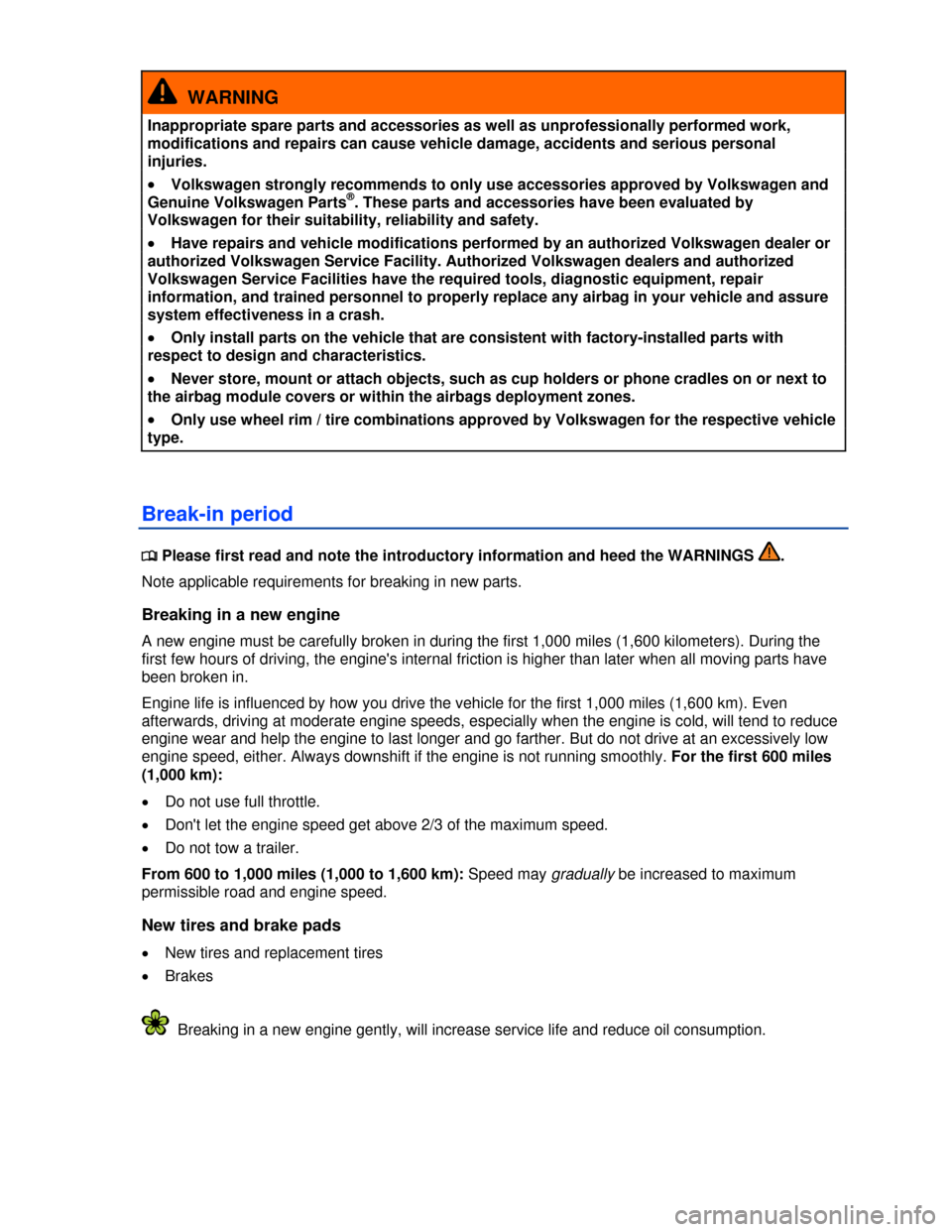2013 VOLKSWAGEN PASSAT ESP
[x] Cancel search: ESPPage 311 of 379

Tire labeling (example) Meaning
Brand, Logo Manufacturer
Tire name Individual tire designation of the manufacturer.
P215 / 55 R 18 Dimensions:
P Tire application: Passenger car
255 Nominal sidewall-to-sidewall width of tire in millimeters.
55 Ratio of height to width (aspect ratio)
R Tire belt design letter code for radial.
18 Rim diameter (in inches)
95 H Load rating code ⇒ page 365 and speed rating code.
XL Indicates “reinforced” tire (heavy-duty)
M+S or M/S Indicates Mud and Snow capability (also M/S).
RADIAL TUBELESS Tubeless radial tire.
E4 ... Labeling according to international regulations (E) including
number of the approving country. The multi-digit approval number
is listed next.
DOT BT RA TY5 1709 Tire identification number (TIN9 - In some cases the
manufacturing date is only on one side of the tire:
DOT The tire complies with the requirements of the United
States Department of Transportation, responsible for
issuing safety standards.
BT Identification letter of the manufacturing site.
RA Manufacturer information regarding tire dimensions.
TY5 Tire characteristics provided by the manufacturer.
1709 Manufacturing date: 17th week in 2009.
TWI Marks the position of the treadwear indicator.
Made in Germany Country of manufacture.
MAX LOAD 615 KG (1356 LBS) United States maximum load rating per wheel.
MAX INFLATION 350 KPA
(51 PSI)
United States maximum permissible inflation pressure.
ROTATION Rotation direction (unidirectional tires)
SIDEWALL 1 PLY RAYON Tire ply composition and materials used:
1 layer of rayon.
TREAD 4 PLIES
1 RAYON + 2 STEEL +
1 NYLON
Tire tread composition and materials used:
In this example there are 4 layers under the tread: 1 layer of
rayon, 2 layers of steel belt and 1 layer of nylon.
Consumer information regarding comparison to specified base tires (standardized test
procedure):
9 TIN represents the serial number of the tire.
Page 319 of 379

Cracking
Any parting within the tread, sidewall, or inner liner of the tire extending to cord material.
Cold tire inflation pressure
The tire pressure recommended by the vehicle manufacturer for a tire of a specified size that has not
been driven for more than a couple of miles (kilometers) at low speeds in the 3 hour period before the
tire pressure is measured or adjusted.
Curb weight
The weight of a motor vehicle with standard equipment including the maximum capacity of fuel, oil,
and coolant, air conditioner, and additional weight of optional equipment.
Extra load tire
A tire designed to operate at higher loads and at higher inflation pressures than the corresponding
standard tire.
Gross Axle Weight Rating (GAWR)
The load-carrying capacity of a single axle system, measured where the tire contacts the ground.
Gross Vehicle Weight Rating (GVWR)
The maximum loaded weight of the vehicle.
Groove
The space between 2 adjacent tread ribs.
Load rating (code)
The maximum load that a tire is rated to carry for a given inflation pressure. You may not find this
information on all tires because it is not required by law.
Maximum load rating
The load rating for a tire at the maximum permissible inflation pressure for that tire.
Maximum loaded vehicle weight
The total of:
�x Curb weight
�x Accessory weight.
�x Vehicle capacity weight.
�x Production options weight.
Maximum (permissible) inflation pressure
The maximum cold inflation pressure to which a tire may be inflated. Also called “maximum inflation
pressure.”
Normal occupant weight
Means 150 lbs (68 kilograms) times the number of occupants seated in the vehicle up to the total
seating capacity of your vehicle.
Occupant distribution
The placement of passengers in a vehicle.
Outer diameter
The diameter of a new, properly inflated tire.
Page 320 of 379

Overall width
Total width measured at the exterior sidewalls of an inflated tire, including the additional width of
labeling, decorations, or protective bands or ribs.
Passenger car tire
A tire intended for use on passenger cars, multipurpose passenger vehicles, and trucks, that have a
gross vehicle weight rating (GVWR) of 10,000 pounds or less.
Ply
A layer of rubber-coated parallel cords.
Ply separation
A parting of rubber compound between adjacent plies.
Pneumatic tire
A mechanical device made of rubber, chemicals, fabric, and steel or other materials, that, when
mounted on an automotive wheel, provides the traction and contains the gas or fluid that sustains the
load.
Production options weight
The combined weight of installed regular production options weighing over 5 lbs (2.3 kg) more then the
standard items they replace, and not previously considered as curb weight or accessory weight. These
include, for example, heavy-duty brakes, ride levelers, heavy-duty battery, and special trim.
Radial ply tires
A pneumatic tire in which the ply cords that extend to the beads are laid at substantially 90 degrees to
the centerline of the tread.
Recommended inflation pressure
The tire pressure recommended by the vehicle manufacturer for a tire of a specified size that has not
been driven for more than a couple of miles (kilometers) at low speeds in the 3 hour period before the
tire pressure is measured or adjusted.
Reinforced tire
A tire designed to operate at higher loads and at higher inflation pressures than the corresponding
standard tire.
Rim
The outer edge of a wheel upon which the tire beads are seated.
Rim diameter
The nominal diameter of the wheel's tire bead seating surface. If you change your wheel size, to
wheels of a different diameter, you will have to purchase new tires to match the new wheels.
Rim size
Designation means rim diameter and width.
Rim type designation
The industry or manufacturer's designation for a rim by style or code.
Rim width
The nominal distance between wheel rim flanges.
Page 323 of 379

Cord separation
The parting of cords from adjacent rubber compounds.
Cracking
Any parting within the tread, sidewall, or inner liner of the tire extending to cord material.
Cold tire inflation pressure
The tire pressure recommended by the vehicle manufacturer for a tire of a specified size that has not
been driven for more than a couple of miles (kilometers) at low speeds in the 3 hour period before the
tire pressure is measured or adjusted.
Curb weight
The weight of a motor vehicle with standard equipment including the maximum capacity of fuel, oil,
and coolant, air conditioner, and additional weight of optional equipment.
Extra load tire
A tire designed to operate at higher loads and at higher inflation pressures than the corresponding
standard tire.
Gross Axle Weight Rating (GAWR)
The load-carrying capacity of a single axle system, measured where the tire contacts the ground.
Gross Vehicle Weight Rating (GVWR)
The maximum loaded weight of the vehicle.
Groove
The space between 2 adjacent tread ribs.
Load rating (code)
The maximum load that a tire is rated to carry for a given inflation pressure. You may not find this
information on all tires because it is not required by law.
Maximum load rating
The load rating for a tire at the maximum permissible inflation pressure for that tire.
Maximum loaded vehicle weight
The total of:
�x Curb weight
�x Accessory weight.
�x Vehicle capacity weight.
�x Production options weight.
Maximum (permissible) inflation pressure
The maximum cold inflation pressure to which a tire may be inflated. Also called “maximum inflation
pressure.”
Normal occupant weight
Means 150 lbs (68 kilograms) times the number of occupants seated in the vehicle up to the total
seating capacity of your vehicle.
Occupant distribution
The placement of passengers in a vehicle.
Page 324 of 379

Outer diameter
The diameter of a new, properly inflated tire.
Overall width
Total width measured at the exterior sidewalls of an inflated tire, including the additional width of
labeling, decorations, or protective bands or ribs.
Passenger car tire
A tire intended for use on passenger cars, multipurpose passenger vehicles, and trucks, that have a
gross vehicle weight rating (GVWR) of 10,000 pounds or less.
Ply
A layer of rubber-coated parallel cords.
Ply separation
A parting of rubber compound between adjacent plies.
Pneumatic tire
A mechanical device made of rubber, chemicals, fabric, and steel or other materials, that, when
mounted on an automotive wheel, provides the traction and contains the gas or fluid that sustains the
load.
Production options weight
The combined weight of installed regular production options weighing over 5 lbs (2.3 kg) more then the
standard items they replace, and not previously considered as curb weight or accessory weight. These
include, for example, heavy-duty brakes, ride levelers, heavy-duty battery, and special trim.
Radial ply tires
A pneumatic tire in which the ply cords that extend to the beads are laid at substantially 90 degrees to
the centerline of the tread.
Recommended inflation pressure
The tire pressure recommended by the vehicle manufacturer for a tire of a specified size that has not
been driven for more than a couple of miles (kilometers) at low speeds in the 3 hour period before the
tire pressure is measured or adjusted.
Reinforced tire
A tire designed to operate at higher loads and at higher inflation pressures than the corresponding
standard tire.
Rim
The outer edge of a wheel upon which the tire beads are seated.
Rim diameter
The nominal diameter of the wheel's tire bead seating surface. If you change your wheel size, to
wheels of a different diameter, you will have to purchase new tires to match the new wheels.
Rim size
Designation means rim diameter and width.
Rim type designation
The industry or manufacturer's designation for a rim by style or code.
Rim width
The nominal distance between wheel rim flanges.
Page 330 of 379

WARNING
Inappropriate spare parts and accessories as well as unprofessionally performed work,
modifications and repairs can cause vehicle damage, accidents and serious personal
injuries.
�x Volkswagen strongly recommends to only use accessories approved by Volkswagen and
Genuine Volkswagen Parts®. These parts and accessories have been evaluated by
Volkswagen for their suitability, reliability and safety.
�x Have repairs and vehicle modifications performed by an authorized Volkswagen dealer or
authorized Volkswagen Service Facility. Authorized Volkswagen dealers and authorized
Volkswagen Service Facilities have the required tools, diagnostic equipment, repair
information, and trained personnel to properly replace any airbag in your vehicle and assure
system effectiveness in a crash.
�x Only install parts on the vehicle that are consistent with factory-installed parts with
respect to design and characteristics.
�x Never store, mount or attach objects, such as cup holders or phone cradles on or next to
the airbag module covers or within the airbags deployment zones.
�x Only use wheel rim / tire combinations approved by Volkswagen for the respective vehicle
type.
Break-in period
�
Page 336 of 379

Applicable only in the United States and Canada
Declaration of Compliance, Telecommunications and
Electronic Systems
Radio Frequency Devices and Radiocommunication Equipment User Manual Notice.
Radio-based equipment
�x Mobile Phone Package
�x Electronic immobilizer.
�x HomeLink® Universal Transmitter.
�x Remote control vehicle key.
�x Keyless Access locking and starting system.
These devices comply with:
FCC Part 15.19
These devices comply with Part 15 of the FCC Rules. Operation is subject to the following 2
conditions:
(1) This device may not cause harmful interference, and
(2) this device must accept any interference received, including interference that may cause undesired
operation.
FCC Part 15.21
CAUTION:
Changes or modifications not expressly approved by the party responsible for compliance could void
the user's authority to operate the equipment.
These devices comply with RSS-210 of Industry Canada.
Operation is subject to the following 2 conditions:
(1) this device may not cause interference, and
(2) this device must accept any interference, including interference that may cause undesired
operation of the device.
The manufacturer is not responsible for any radio or TV interference caused by unauthorized
modifications to this equipment.
Page 337 of 379

Applicable only in Mexico, the AGCC, and South Korea
Declaration of Conformity
The respective manufacturer hereby states that the products listed below at the time of production of
the vehicle comply with the fundamental requirements and the remaining relevant provisions and laws,
amongst others with FCC Part 15.19, FCC Part 15.21 and RSS-Gen Issue 1:
Radio-based equipment
�x Garage door opener.
�x Electronic immobilizer.
�x Remote control vehicle key.
�x Keyless Access locking and starting system.
Electrical equipment
�x 12 Volt socket.